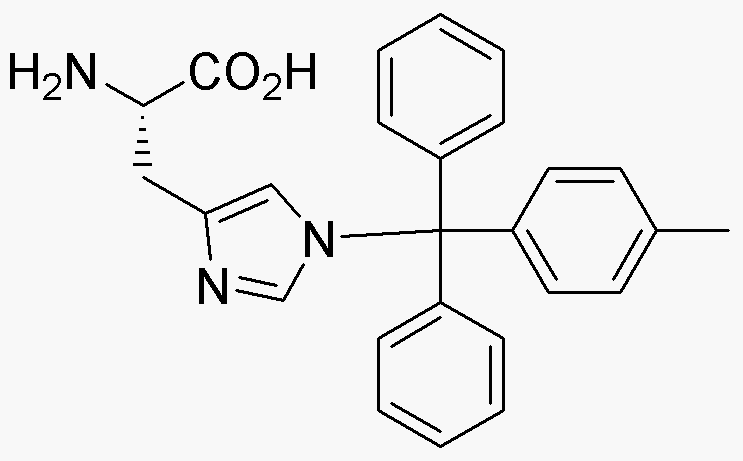Nim-4-Methyltrityl-L-histidine is widely utilized in research focused on:
- Peptide Synthesis: This compound serves as a key building block in the synthesis of peptides, which are essential in drug development and biotechnology.
- Bioconjugation: It is used in bioconjugation processes to attach biomolecules to surfaces or other molecules, enhancing the efficacy of targeted therapies.
- Drug Discovery: Researchers employ this compound in screening assays to identify potential drug candidates, particularly in oncology and immunology.
- Protein Engineering: Its unique structure allows for modifications in protein engineering, leading to the development of novel therapeutic proteins with improved properties.
- Diagnostics: The compound is also explored in the development of diagnostic tools, aiding in the detection of diseases through biomarker identification.
General Information
Properties
Safety and Regulations
Applications
Nim-4-Methyltrityl-L-histidine is widely utilized in research focused on:
- Peptide Synthesis: This compound serves as a key building block in the synthesis of peptides, which are essential in drug development and biotechnology.
- Bioconjugation: It is used in bioconjugation processes to attach biomolecules to surfaces or other molecules, enhancing the efficacy of targeted therapies.
- Drug Discovery: Researchers employ this compound in screening assays to identify potential drug candidates, particularly in oncology and immunology.
- Protein Engineering: Its unique structure allows for modifications in protein engineering, leading to the development of novel therapeutic proteins with improved properties.
- Diagnostics: The compound is also explored in the development of diagnostic tools, aiding in the detection of diseases through biomarker identification.
Documents
Safety Data Sheets (SDS)
The SDS provides comprehensive safety information on handling, storage, and disposal of the product.
Product Specification (PS)
The PS provides a comprehensive breakdown of the product’s properties, including chemical composition, physical state, purity, and storage requirements. It also details acceptable quality ranges and the product's intended applications.
Certificates of Analysis (COA)
Search for Certificates of Analysis (COA) by entering the products Lot Number. Lot and Batch Numbers can be found on a product’s label following the words ‘Lot’ or ‘Batch’.
*Catalog Number
*Lot Number
Certificates Of Origin (COO)
This COO confirms the country where the product was manufactured, and also details the materials and components used in it and whether it is derived from natural, synthetic, or other specific sources. This certificate may be required for customs, trade, and regulatory compliance.
*Catalog Number
*Lot Number
Safety Data Sheets (SDS)
The SDS provides comprehensive safety information on handling, storage, and disposal of the product.
DownloadProduct Specification (PS)
The PS provides a comprehensive breakdown of the product’s properties, including chemical composition, physical state, purity, and storage requirements. It also details acceptable quality ranges and the product's intended applications.
DownloadCertificates of Analysis (COA)
Search for Certificates of Analysis (COA) by entering the products Lot Number. Lot and Batch Numbers can be found on a product’s label following the words ‘Lot’ or ‘Batch’.
*Catalog Number
*Lot Number
Certificates Of Origin (COO)
This COO confirms the country where the product was manufactured, and also details the materials and components used in it and whether it is derived from natural, synthetic, or other specific sources. This certificate may be required for customs, trade, and regulatory compliance.


